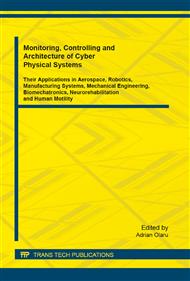[1]
W. Polini and L. Sorrentino, Influence of winding speed and winding trajectory on tension in robotized filament winding of full section parts, Composites Science and Technology 65, 2005, p.1574–1581.
DOI: 10.1016/j.compscitech.2005.01.007
Google Scholar
[2]
L. Markov and R. H. Cheng, Conceptual design of robotics filament winding complexes (Mechatronics Vol. 6, No. 8, 1996, pp.881-896.
DOI: 10.1016/s0957-4158(96)00032-3
Google Scholar
[3]
E. V. Rojas, D. Chapelle, D. Perreux, B. Delobelle and F. Thiebaud, Unified approach of filament winding applied to complex shape mandrels, Composite Structures 116, 2014, p.805–813.
DOI: 10.1016/j.compstruct.2014.06.009
Google Scholar
[4]
F. Hongya, W. Xianfeng, Han Zhenyu and F. Yunzhong, Abnormal Shape Mould Winding, Chinese Journal of Aeronautics, Vol. 20, 2007, pp.552-558.
DOI: 10.1016/s1000-9361(07)60081-8
Google Scholar
[5]
J. Fleischer and J. Schaedel, Joining automotive space frame structures by filament winding, CIRP Journal of Manufacturing Science and Technology, Vol. 6, 2013, p.98–101.
DOI: 10.1016/j.cirpj.2013.02.003
Google Scholar
[6]
M. L. Skinne, Trends, advances and innovations in filament winding, Elsevier, (2006).
Google Scholar
[7]
R. Stewart, Filament winding spins light, strong composite structures with precision, Elsevier, (2009).
Google Scholar
[8]
Y. Xiao, S. Huang, H. Chen and B. Xu, Research on Tension Control Strategy of Battery Pole-piece Winding and Unwinding System Based on Fault-tolerant Control, Procedia Engineering, Vol. 15, 2011, p.5073 – 5078.
DOI: 10.1016/j.proeng.2011.08.942
Google Scholar
[9]
M. Jia and G. Yang, Research of Optical Fiber Coil Winding Model Based on Large-deformation Theory of Elasticity and Its Application, Chinese Journal of Aeronautics, Vol. 24, 2011, pp.640-647.
DOI: 10.1016/s1000-9361(11)60075-7
Google Scholar
[10]
J. Franke and A. Dobroschke, Robot-based winding process for flexible coil production, (2006).
Google Scholar
[11]
S. Chan, M. Munro and A. Fahim, Accuracy-speed relationship of a robot filament winding cell, Robotics & Computer-Integrated Manufacturing, Vol. 12, No. 1, 1996, pp.3-13.
DOI: 10.1016/0736-5845(95)00025-9
Google Scholar
[12]
E. Castro, S. Seereeram, J. Singh, A.A. Desrochers and J.T. Wen, A Real-Time Computer Controller for a Robotic Filament Winding System, Journal of Intelligent and Robotic Systems 1, 1993, pp.73-91.
DOI: 10.1007/bf01258213
Google Scholar
[13]
NewsRx, Machine for Winding a Fiber Texture onto an Impregnation Mandrel, and the Use of Such a Machine for Making a Gas Turbine Casing Out of Composite Material, ProQuest Central, (2014).
Google Scholar
[14]
G. Zhang, Z. Zhao and J. Zhou, U.S. Patent 8, 418, 579, (2013).
Google Scholar
[15]
R. Schmitt and A. Witte, Control of a thermoplastic tape winding process with optical in-line metrology, Proceedings in Manufacturing Systems, Vol. 7, 2012, Issue 3.
Google Scholar
[16]
E. Hultman and M. Leijon, Utilizing cable winding and industrial robots to facilitate the manufacturing of electric machines, Robotics and Computer-Integrated Manufacturing, Vol. 29, 2013, p.246–256.
DOI: 10.1016/j.rcim.2012.06.005
Google Scholar
[17]
E. Hultman and M. Leijon, A cable feeder tool for robotized cable winding, Robotics and Computer-Integrated Manufacturing, Vol. 30, 2014, p.577–588.
DOI: 10.1016/j.rcim.2014.04.003
Google Scholar
[18]
K. Bubeck, U.S. Patent 4, 750, 960, (1988).
Google Scholar
[19]
C. Paltinisanu, Materialecompozitepentrucomponente ale mecanismului de directive, Master thesis, Mechanical Faculty, Transilvania University Brasov, (2013).
Google Scholar
[20]
T. Heitz, Performantelefizico-mecanica ale pieselor din material composite utilizate pentru coloana de directive a autovehiculelor, PhDr thesis, Mechanical Engineering Faculty, Transilvania University Brasov, (2013).
Google Scholar


